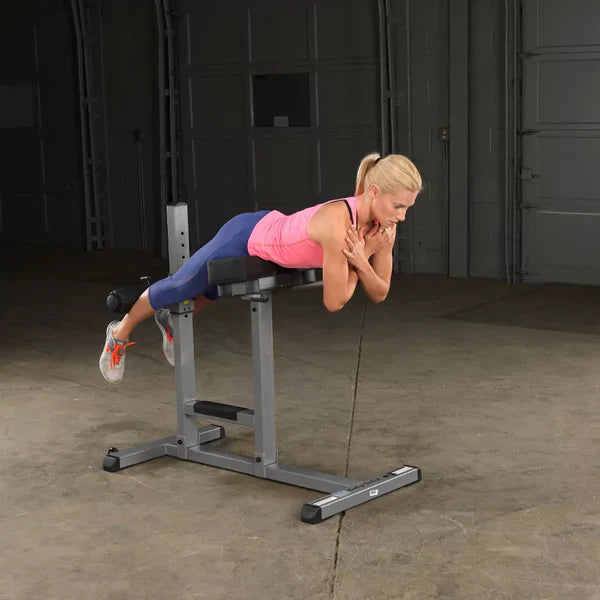In the age of home fitness, finding the right equipment can transform your workouts from average to exceptional. One piece of equipment that’s often overlooked but incredibly powerful is the hyperextension bench—also known as a Roman chair. If you're building out your home gym or simply looking for a way to improve your back, core, and glute strength, the hyperextension deserves your attention.
This article explores why a hyperextension is a must-have for any fitness enthusiast, the hyperextension benefits, how to choose the best hyperextension for home gym, and how to incorporate a hyperextension workout routine at home.
What Is a Hyperextension Machine?
A hyperextension bench is a specialized piece of gym equipment designed to facilitate exercises that target the lower back, glutes, hamstrings, and core. Most models allow users to adjust the angle and height, making it easy to customize based on your fitness level and body type.
There are two primary types:
-
45-degree hyperextension bench: Ideal for beginners and suitable for smaller spaces.
-
90-degree (Roman chair): Allows for a full range of motion and more intense core and back workouts.
Hyperextension Benefits: More Than Just Back Support
Adding a hyperextension to your home gym setup opens the door to a host of benefits:
1. Strengthens Lower Back Muscles
Lower back pain is a common issue, especially for those who sit for long periods. Hyperextension exercises specifically target the erector spinae, which helps support your spine and improve posture.
2. Improves Core Stability
While many think of crunches for core work, hyperextensions engage the deep abdominal muscles, including the transverse abdominis and obliques. This helps build a solid, injury-resistant core.
3. Boosts Glute and Hamstring Activation
During a hyperextension exercise, your glutes and hamstrings are activated in tandem with your back. This makes the hyperextension bench a great addition to leg day routines.
4. Enhances Posture and Alignment
Strengthening the posterior chain helps balance the effects of sitting and poor posture, making you look taller and more confident.
5. Prevents Injury
A strong lower back and core are key to injury prevention—whether you're lifting weights, running, or just moving through your daily routine.
Best Hyperextension for Home Gym: What to Look For
Not all hyperextension benches are created equal. To find the best hyperextension for home gym, consider these factors:
1. Size and Storage
If you’re tight on space, look for a foldable hyperextension bench or one with a smaller footprint. The 45-degree models are often more compact.
2. Adjustability
Height and angle adjustments ensure proper form and reduce injury risk. The more adjustable the bench, the more versatile it will be for multiple users.
3. Build Quality
Look for durable materials, especially steel frames and padded supports. A sturdy frame ensures stability during workouts.
4. Weight Capacity
Make sure the bench can support your body weight plus any additional load you might add (e.g., holding a weight plate during exercises).
5. Price vs. Features
You don’t need to break the bank to get a good product, but it’s worth investing a little more for longevity and comfort.
Top picks for 2025 include:
-
Titan Fitness Adjustable Hyperextension Bench
-
Marcy JD-3.1 Roman Chair
-
Rogue GH-1 GHD Machine (for advanced users)
Hyperextension Workout Routine at Home
Now that you've got the equipment, how do you use it effectively? Here’s a sample hyperextension workout routine at home that targets your entire posterior chain.
1. Basic Back Extensions (3 sets of 15 reps)
-
Focus: Lower back
-
Tip: Keep a neutral spine and avoid overextending.
2. Weighted Hyperextensions (3 sets of 12 reps)
-
Focus: Glutes, hamstrings, and back
-
Tip: Hold a weight plate or dumbbell close to your chest.
3. Side Bends on Hyperextension Bench (3 sets of 15 reps each side)
-
Focus: Obliques
-
Tip: Rotate slightly as you lift to activate more muscle fibers.
4. Glute Raises (3 sets of 20 reps)
-
Focus: Glutes
-
Tip: Emphasize squeezing your glutes at the top.
5. Supermans on Floor (3 sets of 30 seconds hold)
-
Focus: Full posterior chain
-
Tip: Hold for time rather than reps for endurance.
This hyperextension workout routine at home can be done 2–3 times a week and pairs well with both upper and lower body days.
Tips for Safe and Effective Hyperextension Workouts
-
Warm Up First: Activate the muscles with light cardio and dynamic stretching.
-
Start Slow: Especially if you're new, start with bodyweight only to master form.
-
Avoid Hyperextending the Spine: Only raise your torso until it’s aligned with your legs.
-
Control the Tempo: Slow, controlled movements are more effective than fast reps.
-
Listen to Your Body: If you feel pain (not to be confused with muscle fatigue), stop immediately.
Why You Should Add a Hyperextension Bench Today
If you're serious about building a well-rounded, injury-resistant body, then a hyperextension bench is a smart investment. It's compact, versatile, and incredibly effective at targeting some of the most neglected muscles in the body.
In a sea of resistance bands, dumbbells, and high-tech treadmills, this simple bench stands out by offering unmatched value—especially when considering its positive impact on posture, performance, and pain prevention.
Final Thoughts
Whether you're a beginner working out in your basement or a seasoned athlete crafting the ultimate home fitness haven, incorporating a hyperextension bench can take your training to the next level. With the right routine and equipment, you'll enjoy all the hyperextension benefits while minimizing your risk of injury and maximizing your performance.
Don’t wait—search for the best hyperextension for home gym, set up your space, and start experiencing the transformation today.





